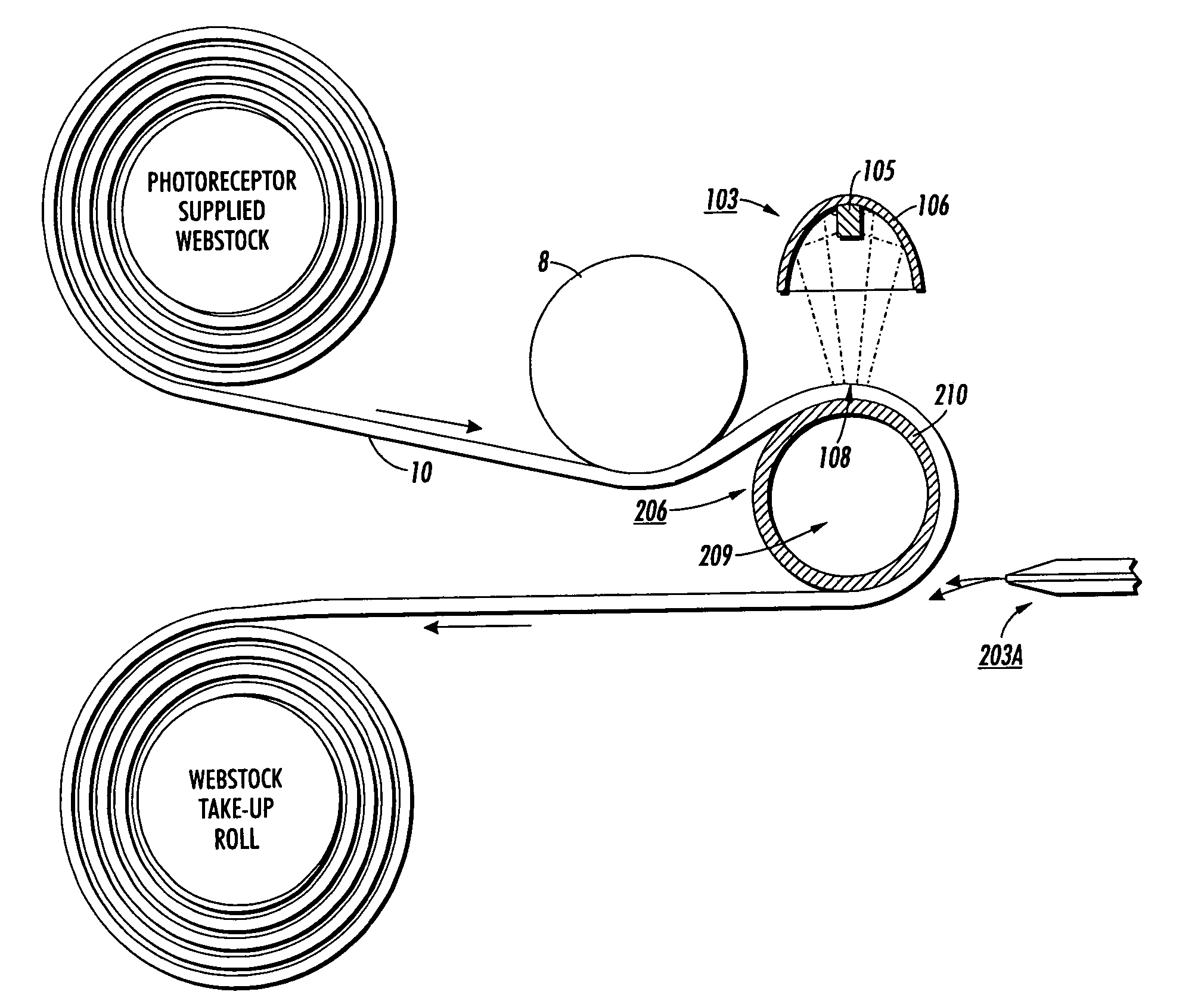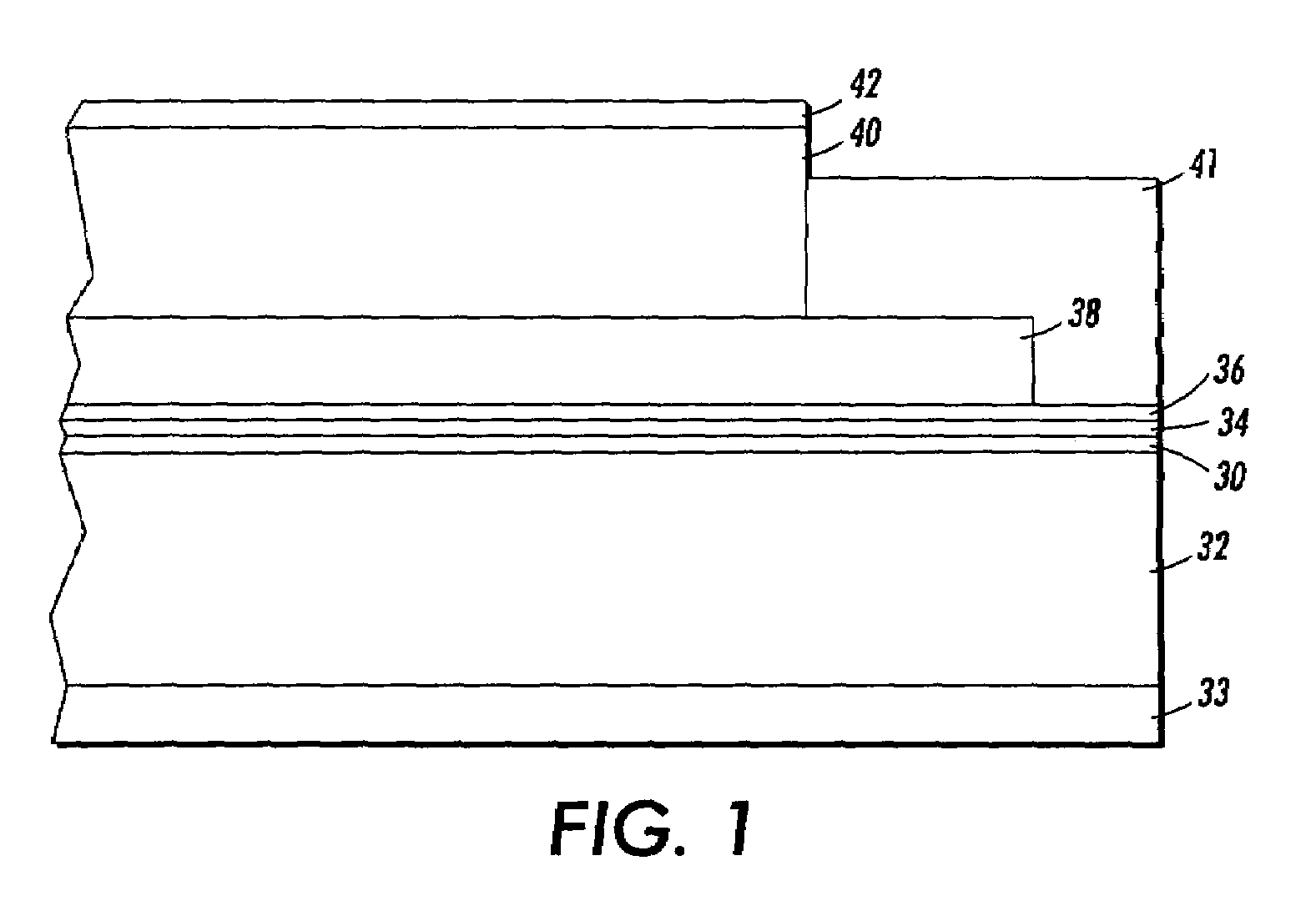Stress release method and apparatus
a multi-layer, stress-releasing technology, applied in the direction of electrographic process, electric/magnetic/electromagnetic heating, instruments, etc., can solve the problems of mechanical fatigue of the outer-most charge transport layer, the deformation of the image quality during extended cycling, and so as to prolong the mechanical service life of the imaging member, reduce the internal and reduce the bending strain of the charge transport layer
- Summary
- Abstract
- Description
- Claims
- Application Information
AI Technical Summary
Benefits of technology
Problems solved by technology
Method used
Image
Examples
control example i
[0103]A flexible electrophotographic imaging member web stock, in reference to the illustration in FIG. 1, is prepared by providing a 0.01 μm thick titanium layer 30 coated onto a flexible biaxially oriented Polynaphthalate substrate support layer 32 (Kadalex®, available from ICI Americas, Inc.) having a thermal contraction coefficient of about 1.8×10−5 / ° C., a glass transition temperature Tg of 130° C., and a thickness of 3.5 mils or 88.7 μm, and applying thereto, by a gravure coating process, a solution containing 10 grams gamma aminopropyltriethoxy silane, 10.1 grams distilled water, 3 grams acetic acid, 684.8 grams of 200 proof denatured alcohol and 200 grams heptane. This layer is then dried at 125° C. in a forced air oven. The resulting blocking layer 34 has an average dry thickness of 0.05 μm measured with an ellipsometer.
[0104]An adhesive interface layer is extrusion coated by applying to the blocking layer a wet coating containing 5 percent by weight based on the total weig...
control example ii
[0108]Another flexible electrophotographic imaging member web stock is prepared by following the procedures and using materials as described in the Control Example I, but with the exception that the imaging member web stock curling is controlled by application of an anticurl back coating 33 to render the desired imaging member web stock flatness.
[0109]An anticurl back coating solution is prepared by combining 8.82 grams of polycarbonate resin (Makrolon 5705®, available from Bayer AG), 0.72 gram of polyester resin (Vitel PE-200®, available from Goodyear Tire and Rubber Company) and 90.1 grams of methylene chloride in a glass container to form a coating solution containing 8.9 percent by weight solids. The container is covered tightly and placed on a roll mill for about 24 hours until the polycarbonate and polyester are dissolved in the methylene chloride to form the anticurl back coating solution. The anticurl back coating solution is then applied to the rear surface of the substrate...
example i
[0116]A two hundred feet long flexible electrophotographic imaging member web stock 10 full device of Control Example II is used for charge transport layer (CTL) heat stress release processing treatment according to the pictorial representation shown in FIG. 3. This processing follows the same procedures as in Comparative Example I, except that the processing is modified to include a concave idled roller 8 as shown in FIG. 3, according to the present invention. A second two hundred feet long imaging member web stock 10 of Control Example II is also used for CTL stress release processing treatment according to the invention process of FIG. 4, but utilizing two identical concave rollers 8, 28. The concave rollers 8, 28 are as that illustrated in FIG. 5, particularly having a 3 inch diameter at the roller center and with larger diameters at each end, to give a diameter differential of 0.015 inch. These two imaging member web stocks are each separately stress release treated, according ...
PUM
| Property | Measurement | Unit |
|---|---|---|
| diameter | aaaaa | aaaaa |
| diameter | aaaaa | aaaaa |
| diameter | aaaaa | aaaaa |
Abstract
Description
Claims
Application Information
 Login to View More
Login to View More - R&D
- Intellectual Property
- Life Sciences
- Materials
- Tech Scout
- Unparalleled Data Quality
- Higher Quality Content
- 60% Fewer Hallucinations
Browse by: Latest US Patents, China's latest patents, Technical Efficacy Thesaurus, Application Domain, Technology Topic, Popular Technical Reports.
© 2025 PatSnap. All rights reserved.Legal|Privacy policy|Modern Slavery Act Transparency Statement|Sitemap|About US| Contact US: help@patsnap.com



